| Order-4 octagonal tiling | |
|---|---|
 Poincaré disk model of the hyperbolic plane | |
| Type | Hyperbolic regular tiling |
| Vertex configuration | 84 |
| Schläfli symbol | {8,4} r{8,8} |
| Wythoff symbol | 4 | 8 2 |
| Coxeter diagram | |
| Symmetry group | [8,4], (*842) [8,8], (*882) |
| Dual | Order-8 square tiling |
| Properties | Vertex-transitive, edge-transitive, face-transitive |
In geometry, the order-4 octagonal tiling is a regular tiling of the hyperbolic plane. It has Schläfli symbol of {8,4}. Its checkerboard coloring can be called a octaoctagonal tiling, and Schläfli symbol of r{8,8}.
Uniform constructions[edit]
There are four uniform constructions of this tiling, three of them as constructed by mirror removal from the [8,8] kaleidoscope. Removing the mirror between the order 2 and 4 points, [8,8,1+], gives [(8,8,4)], (*884) symmetry. Removing two mirrors as [8,4*], leaves remaining mirrors *4444 symmetry.
| Uniform Coloring |

|
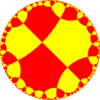
|
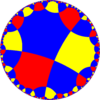
|
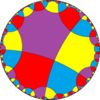
|
|---|---|---|---|---|
| Symmetry | [8,4] (*842) |
[8,8] (*882) |
[(8,4,8)] = [8,8,1+] (*884)
|
[1+,8,8,1+] (*4444) |
| Symbol | {8,4} | r{8,8} | r(8,4,8) = r{8,8}1⁄2 | r{8,4}1⁄8 = r{8,8}1⁄4 |
| Coxeter diagram |
|
Symmetry[edit]
This tiling represents a hyperbolic kaleidoscope of 8 mirrors meeting as edges of a regular hexagon. This symmetry by orbifold notation is called (*22222222) or (*28) with 8 order-2 mirror intersections. In Coxeter notation can be represented as [8*,4], removing two of three mirrors (passing through the octagon center) in the [8,4] symmetry. Adding a bisecting mirror through 2 vertices of an octagonal fundamental domain defines a trapezohedral *4422 symmetry. Adding 4 bisecting mirrors through the vertices defines *444 symmetry. Adding 4 bisecting mirrors through the edge defines *4222 symmetry. Adding all 8 bisectors leads to full *842 symmetry.
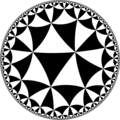 *444 |
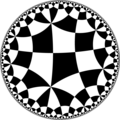 *4222 |
 *832 |
The kaleidoscopic domains can be seen as bicolored octagonal tiling, representing mirror images of the fundamental domain. This coloring represents the uniform tiling r{8,8}, a quasiregular tiling and it can be called a octaoctagonal tiling.

|
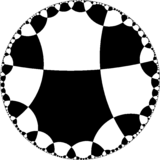
|
Related polyhedra and tiling[edit]
This tiling is topologically related as a part of sequence of regular tilings with octagonal faces, starting with the octagonal tiling, with Schläfli symbol {8,n}, and Coxeter diagram ![]()
![]()
![]()
![]()
![]() , progressing to infinity.
, progressing to infinity.
| *n42 symmetry mutation of regular tilings: {n,4} | |||||||
|---|---|---|---|---|---|---|---|
| Spherical | Euclidean | Hyperbolic tilings | |||||

|

|

|

|

|

|

|

|
| 24 | 34 | 44 | 54 | 64 | 74 | 84 | ...∞4 |
| Regular tilings: {n,8} | |||||||||||
|---|---|---|---|---|---|---|---|---|---|---|---|
| Spherical | Hyperbolic tilings | ||||||||||
 {2,8} |
 {3,8} |
 {4,8} |
 {5,8} |
 {6,8} |
 {7,8} |
 {8,8} |
... |  {∞,8} | |||
This tiling is also topologically related as a part of sequence of regular polyhedra and tilings with four faces per vertex, starting with the octahedron, with Schläfli symbol {n,4}, and Coxeter diagram ![]()
![]()
![]()
![]()
![]() , with n progressing to infinity.
, with n progressing to infinity.
 {3,4} |
 {4,4} |
 {5,4} |
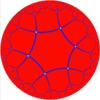 {6,4} |
 {7,4} |
 {8,4} |
... |  {∞,4} |
| Uniform octagonal/square tilings | |||||||||||
|---|---|---|---|---|---|---|---|---|---|---|---|
| [8,4], (*842) (with [8,8] (*882), [(4,4,4)] (*444) , [∞,4,∞] (*4222) index 2 subsymmetries) (And [(∞,4,∞,4)] (*4242) index 4 subsymmetry) | |||||||||||
= = = |
= |
= = = |
= |
= = |
= |
||||||

|

|

|

|

|

|

| |||||
| {8,4} | t{8,4} |
r{8,4} | 2t{8,4}=t{4,8} | 2r{8,4}={4,8} | rr{8,4} | tr{8,4} | |||||
| Uniform duals | |||||||||||

|

|

|

|

|

|

| |||||
| V84 | V4.16.16 | V(4.8)2 | V8.8.8 | V48 | V4.4.4.8 | V4.8.16 | |||||
| Alternations | |||||||||||
| [1+,8,4] (*444) |
[8+,4] (8*2) |
[8,1+,4] (*4222) |
[8,4+] (4*4) |
[8,4,1+] (*882) |
[(8,4,2+)] (2*42) |
[8,4]+ (842) | |||||
= |
= |
= |
= |
= |
= |
||||||

|

|

|

|

|

|

| |||||
| h{8,4} | s{8,4} | hr{8,4} | s{4,8} | h{4,8} | hrr{8,4} | sr{8,4} | |||||
| Alternation duals | |||||||||||

|

|

|

|

|
|||||||
| V(4.4)4 | V3.(3.8)2 | V(4.4.4)2 | V(3.4)3 | V88 | V4.44 | V3.3.4.3.8 | |||||
| Uniform octaoctagonal tilings | |||||||||||
|---|---|---|---|---|---|---|---|---|---|---|---|
| Symmetry: [8,8], (*882) | |||||||||||
= |
= |
= |
= |
= |
= |
= | |||||

|

|

|

|

|

|

| |||||
| {8,8} | t{8,8} |
r{8,8} | 2t{8,8}=t{8,8} | 2r{8,8}={8,8} | rr{8,8} | tr{8,8} | |||||
| Uniform duals | |||||||||||

|

|

|

|

|

|

| |||||
| V88 | V8.16.16 | V8.8.8.8 | V8.16.16 | V88 | V4.8.4.8 | V4.16.16 | |||||
| Alternations | |||||||||||
| [1+,8,8] (*884) |
[8+,8] (8*4) |
[8,1+,8] (*4242) |
[8,8+] (8*4) |
[8,8,1+] (*884) |
[(8,8,2+)] (2*44) |
[8,8]+ (882) | |||||
= |
= | ||||||||||

|

|

|

|

| |||||||
| h{8,8} | s{8,8} | hr{8,8} | s{8,8} | h{8,8} | hrr{8,8} | sr{8,8} | |||||
| Alternation duals | |||||||||||

|

|
||||||||||
| V(4.8)8 | V3.4.3.8.3.8 | V(4.4)4 | V3.4.3.8.3.8 | V(4.8)8 | V46 | V3.3.8.3.8 | |||||
See also[edit]
References[edit]
- John H. Conway, Heidi Burgiel, Chaim Goodman-Strauss, The Symmetries of Things 2008, ISBN 978-1-56881-220-5 (Chapter 19, The Hyperbolic Archimedean Tessellations)
- "Chapter 10: Regular honeycombs in hyperbolic space". The Beauty of Geometry: Twelve Essays. Dover Publications. 1999. ISBN 0-486-40919-8. LCCN 99035678.


Well, that’s interesting to know that Psilotum nudum are known as whisk ferns. Psilotum nudum is the commoner species of the two. While the P. flaccidum is a rare species and is found in the tropical islands. Both the species are usually epiphytic in habit and grow upon tree ferns. These species may also be terrestrial and grow in humus or in the crevices of the rocks.
View the detailed Guide of Psilotum nudum: Detailed Study Of Psilotum Nudum (Whisk Fern), Classification, Anatomy, Reproduction